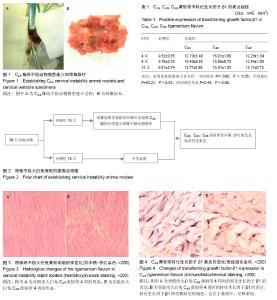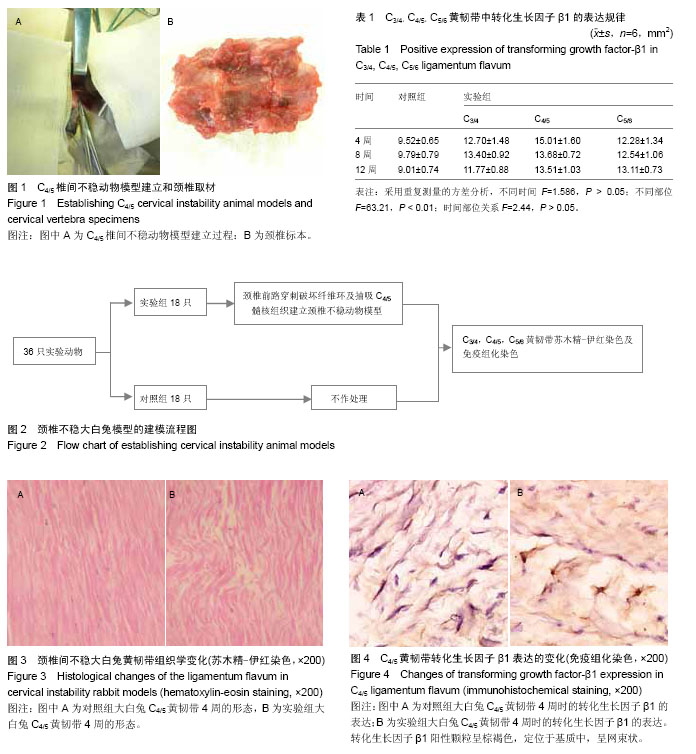| [1] |
Hu Wandong, He Jialin, Zhang Longsheng, Liao Wenbo.
Differential proteomics study of patients with sternal ossification of the ligamentum flavum
[J]. Chinese Journal of Tissue Engineering Research, 2021, 25(17): 2625-2629.
|
| [2] |
Xu Guofeng, Li Xuebin, Tang Yifan, Zhao Yin, Zhou Shengyuan, Chen Xiongsheng, Jia Lianshun.
The role of autophagy in ossification of the human ligamentum
flavum
[J]. Chinese Journal of Tissue Engineering Research, 2020, 24(8): 1174-1181.
|
| [3] |
Zhang Fangxin, Kang Peng, Wang Qiteng, Zhang Xiao, Liu Wei, Yang Hongtao, Aierken•Amudong.
Apoptosis and expression of apoptotic factors caspase-3, fas
and p53 in lumbar ligamentum flavum
[J]. Chinese Journal of Tissue Engineering Research, 2020, 24(8): 1195-1199.
|
| [4] |
Shen Canghai, Feng Yongjian, Song Yancheng, Liu Gang, Liu Zhiwei, Wang Ling, Dai Haiyang.
Value of quantitative MRI T2WI parameters in predicting
surgical outcome of thoracic ossification of the ligamentum flavum
[J]. Chinese Journal of Tissue Engineering Research, 2020, 24(18): 2893-2899.
|
| [5] |
Liang Long, Wei Xu, Zhu Liguo, Yin He, Yu Jie, Feng Minshan, Chen Lin.
Cervical posterior single-door laminoplasty versus double-door laminoplasty for cervical spondylotic myelopathy: a meta-analysis
[J]. Chinese Journal of Tissue Engineering Research, 2019, 23(8): 1299-1306.
|
| [6] |
Li Shuwen, Yang Zhe, Yin Heping, Wu Yimin, Bai Ming, Du Zhicai, Wang Yupeng, Meng Gedong.
Preserving ligamentum flavum for preventing dural adhesions after lumbar surgery in model rabbits
[J]. Chinese Journal of Tissue Engineering Research, 2019, 23(3): 416-420.
|
| [7] |
Zhu Xu, Shen Jun, Yang Rongkun, Wang Yong, Liu Yang, Sun Quan, He Zhuying, Chen Jiuyi.
Mechanism of traditional Chinese medicine Shixiang plaster in promoting the repair of soft tissue defects
[J]. Chinese Journal of Tissue Engineering Research, 2019, 23(27): 4350-4355.
|
| [8] |
Liang Lichang1, 2, Fan Yawen1, 2, Mu Lei1, 2, Xie Tian1, 2, Jiang Xiaobing3, Ren Hui3, Zhang Tianfeng1.
Changes of kidney in rat models of type 2 diabetes mellitus after administering Lizhong Decoction
[J]. Chinese Journal of Tissue Engineering Research, 2019, 23(27): 4356-4362.
|
| [9] |
Li Pengfei, Wang Tao, Ma Xinlong .
Association between COL9A2 gene polymorphisms and intervertebral disc degeneration in Asian: a meta-analysis
[J]. Chinese Journal of Tissue Engineering Research, 2019, 23(20): 3275-3280.
|
| [10] |
Zhang Xiang1, Qian Yuzhang1, Xie Lin2, 3, Kang Ran2, 3 .
Technological methods and result evaluation of establishing the animal models of vertebral artery type of cervical spondylosis
[J]. Chinese Journal of Tissue Engineering Research, 2019, 23(15): 2427-2435.
|
| [11] |
Tang Fubo, Zhou Jinyan, Zhang Yisheng, Zhong Yuanming, Li Zhifei, Mo Yi.
Risk factors associated with titanium cage subsidence after anterior single-level subtotal corpectomy and interbody fusion using titanium cage
[J]. Chinese Journal of Tissue Engineering Research, 2019, 23(12): 1818-1823.
|
| [12] |
Tian Yi-xing, Bao Zhao-hua, Zou Jun, Ji Yi-ming, Mei Xin, Pan Jun, He Wen-ye, Yang Hui-lin.
Short-term effectiveness of single-level Isobar TTL dynamic internal fixation in the treatment of lumbar degenerative diseases
[J]. Chinese Journal of Tissue Engineering Research, 2018, 22(7): 1020-1025.
|
| [13] |
Lu Ying-jie, Bao Wei-guo, Zou Jun, Zhou Feng, Jiang Wei-min, Yang Hui-lin, Zhang Zhi-ming, Zhu Xue-song.
Related factors for dysphagia after single-level anterior cervical descectomy and fusion
[J]. Chinese Journal of Tissue Engineering Research, 2018, 22(7): 1026-1031.
|
| [14] |
Yin Xun-lu1, Feng Min-shan1, 2, Zhu Li-guo1, 2, Li Xue-peng1, Chen Lin3, Li Ling-hui1, Zhan Jia-wen1, Wei Xu1.
Animal models of intervertebral disc degeneration: economy, feasibility, reliability and controllability
[J]. Chinese Journal of Tissue Engineering Research, 2018, 22(4): 619-624.
|
| [15] |
Chen Yongjun, Zhong Hua, Hua Qiang, Lin Yongxiang, Li Hua, Hu Zhiping, Duan Shaoyin, Zhao Huiyi .
Preoperative planning and operative simulation of three-dimensional printing-assisted upper cervical spine tumor model
[J]. Chinese Journal of Tissue Engineering Research, 2018, 22(35): 5614-5619.
|

